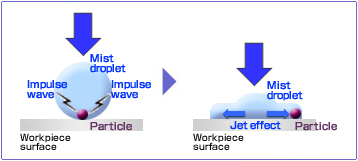Debris and Particle Removal
Solutions
CCD and CMOS image sensors, now quite common in digital cameras and mobile phones, are extremely
sensitive to particles. Further, the adhesion of debris to IC bonding pads can result in bonding failure.
DISCO handles potentially harmful particles and debris with a variety of machine features and
applications.
Application: Atomizing Nozzle Technology
Atomizing nozzle technology offers more cleaning power than ordinary high-pressure cleaning. An atomizing nozzle on the dicer wheel cover effectively eliminates particles that can adhere to microlenses, while an atomizing nozzle on the spinner table eliminates silicon debris that can stick to bonding pads.
Comparison of pad area cleansing effect after dicing
-
Spinner with high-pressure cleaning

-
Spinner with atomizing nozzle

Benefits of Atomizing Nozzle Technology
The atomizing nozzle combines water and high-pressure air to emit extremely small mist droplets at high speed. When a mist droplet hits the wafer, it creates both an impulse wave and an expansion wave. It also creates a jet of water that passes over the wafer surface laterally. When the mist droplet hits a particle directly, it peels the particle from the wafer; when it does not hit a particle directly, the jet effect it produces serves to wash the particle off the wafer.

Because the atomizing nozzle offers superior cleaning power and does not require regular replacement of the nozzle or other consumables, it can be an improvement over an ordinary high-pressure pump, which typically employs pressures in the range of 6 - 10 MPa.
Other Strategies
Atomizing nozzle technology is one important DISCO strategy for handling debris and particles, but other options are available:
- Adjustment or complete change of wheel cover nozzles
- The use of special cutting liquids
- Optimization of cutting water flow rates
- Overall optimization of processing conditions
Contact
Please feel free to contact us with any questions or inquiries.
-

Applications Support
A free-of-charge test cut is performed at an application lab to confirm whether achieving the customer's needs is possible.
Details -

Dicing and Grinding Service
It is effective in sample and prototype manufacturing during development or low-volume production. Designated engineers will provide support based on the desired leadtime and at reasonable cost.
Details
